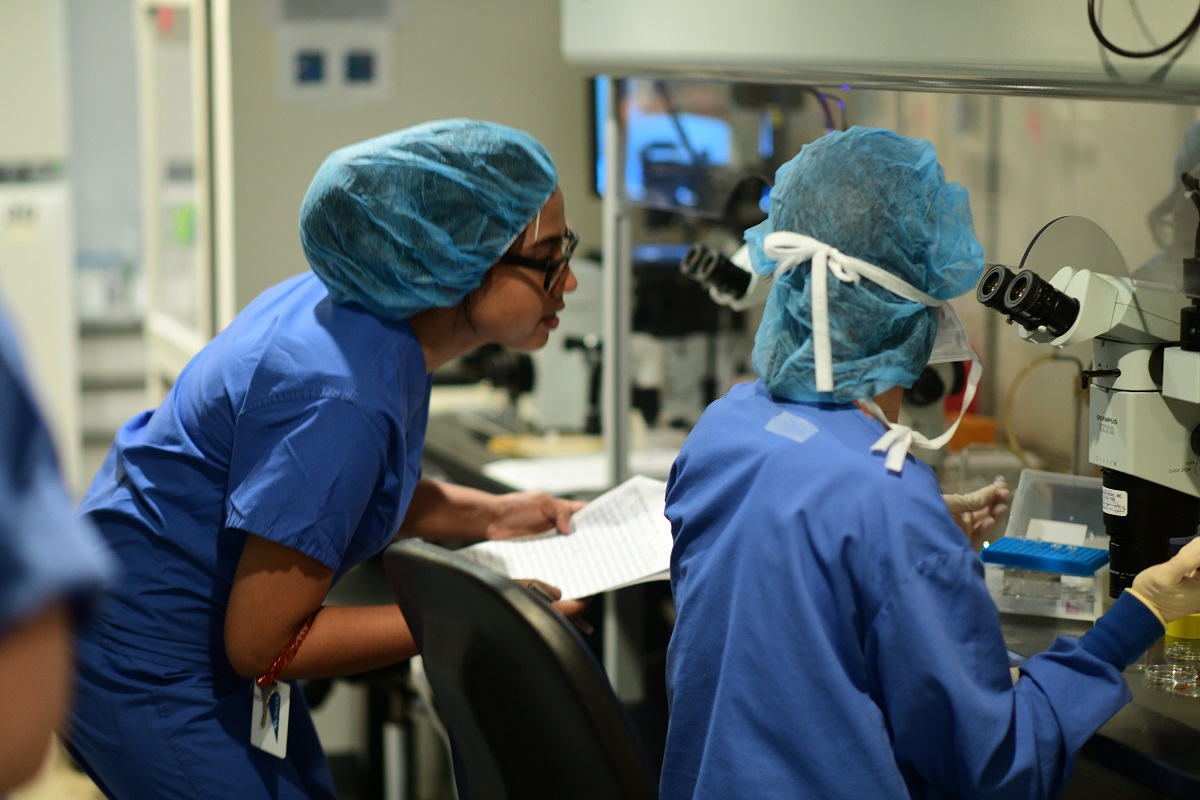A Day in the Life of an Embryologist

In honor of World Embryologist Day, we asked Donna, senior embryologist at RMA of New York, to provide insight into a day in the life of an embryologist. Embryologists work largely behind the scenes, yet their work significantly contributes to creating families for those facing infertility. Donna recounts her own journey to becoming an embryologist, the daily tasks she performs, and the protocols in place to keep patients’ genetic materials secure.
Why were you drawn to a career in embryology and what kind of education did you pursue to become an embryologist?
I developed an interest for In Vitro Fertilization (IVF) when I worked in the Gamete and Embryo research lab of Dr. Susan Lanzendorf at the Jones Institute of Reproductive Medicine, which is affiliated with Eastern Virginia Medical School. I received my Bachelor’s degree at Hampton University in Hampton, Virginia and then my Masters in clinical biology from East Virginia Medical School in Norfolk, Virginia. I worked at the Jones Institute in both research and clinical care for 15 years before I began working at RMA of New York, where I have been for the last 7 years.
What is a typical work day like for you?
My day begins with egg /embryo thaws, embryo biopsies or fertilization checks. Occasionally, I perform a Testicular Sperm Extraction (TESE) sperm search in which I locate, identify, and isolate sperm from a sample aspiration. I may also perform egg retrievals in which a physician uses ultrasound guidance to draw eggs from their follicles into individual test tubes. My job is to collect the test tubes and place those eggs into a culture dish so that they can begin to mature. The timing of this process is crucial to ensure the eggs are in a nurturing environment where they can grow.
Most afternoons I am performing embryo transfers, or preparing samples to be transferred back into the patient in hopes of implantation. I also freeze eggs, embryos, or sperm for future use. Intracytoplasmic Sperm Injection (ICSI) is another procedure I may perform in the afternoon. I directly inject sperm into an egg with the goal of increasing the likelihood that the egg will be fertilized.
Lab duties alternate according to staff availability and patient procedure schedule. Work can be intense and every day can be very different, but my favorite part of my job is seeing the joy on patients’ faces.
With so many different services how do you learn each technique?
To learn the various techniques it is important to read the protocols, observe, and then practice until you feel proficient and confident. After practicing a certain number of times you are observed. Once you have mastered a particular technique then you can carry on with the procedure on your own. The training regimen is intense but prepares you for the work that is required.
Do all IVF clinics offer the same kind of training for their embryologists?
Training varies in different labs based on lab management. At our lab, the handling of eggs and sperm and the culturing of embryos is handled by highly trained embryology and andrology specialists. RMA of New York has a large and experienced laboratory team that is committed to upholding the highest standards of safety and precision to achieve superior success rates and health pregnancy outcomes for our patients. I received extensive training and education to ensure that I use the most advanced technologies to increase implantation rates, reduce miscarriage rates, and increase live birth rates.
There have been lots of advances in lab equipment, embryo culture, cryopreservation, and embryo biopsy since I began my career. This means that as an embryologist I have to adapt. Learning never ends. I look forward to the continuous journey.
How can you reassure patients that their eggs, sperm, or embryos are safely stored?
All devices that come into contact with the patient’s material are labelled with multiple identifiers. When a patient’s material is moved from one device to the next, a witness must confirm the patient’s identity. The incubator in which the patient’s materials are stored is also labelled. All embryos are stored on individual canes. Each cane has the patient identifier in three different places: the label on the freezing device, the cane goblet holding the device, and the cane itself. The location of the cane is entered into the patient’s electronic medical record, which is then added onto the patient’s chart when it is printed for thaw. When a thaw occurs, the identifying label on the device is double checked by two trained embryologist to confirm that all information matches the paper work. The thawed embryo is placed in a dish which has a label that is also double checked and a picture of the embryo is taken post thaw. During the transfer, the patient’s identity is confirmed by checking their wrist band to the patient’s chart. The patient is shown the dish label and confirms their information before the transfer occurs. All of these protocols ensure that we execute our procedures using only the patient’s and partner’s genetic material.
